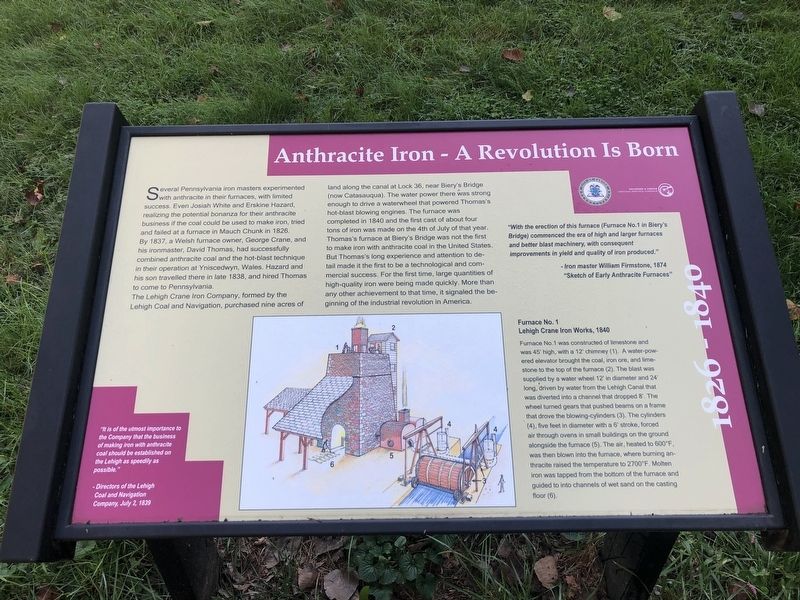Easton in Northampton County, Pennsylvania — The American Northeast (Mid-Atlantic)
Anthracite Iron - A Revolution Is Born
1826 - 1840

Photographed By Devry Becker Jones (CC0), October 3, 2020
1. Anthracite Iron - A Revolution Is Born Marker
"With the erection of this furnace (Furnace No. 1 in Biery's Bridge) commenced the era of high and larger furnaces and better blast machinery, with consequent improvements in yield and quality of iron produced."
— Iron master William Firmstone, 1874
"Sketch of Early Anthracite Furnaces"
Several Pennsylvania iron masters experimented with anthracite in their furnaces, with limited success. Even Josiah White and Erskine Hazard, realizing the potential bonanza for their anthracite business if the coal could be used to make iron, tried and failed at a furnace in Mauch Chunk in 1826. By 1837, a Welsh furnace owner, George Crane, and his ironmaster, David Thomas, had successfully combined anthracite coal and the hot-blast technique in their operation in Yniscedwyn, Wales. Hazard and his son travelled there in late 1838, and hired Thomas to come to Pennsylvania.
The Lehigh Crane Iron Company, formed by the Lehigh Coal and Navigation, purchased nine acres of land along the canal at Lock 36, near Biery's Bridge (now Catasauqua). The water power there was strong enough to drive a waterwheel that powered THomas's hot-blast blowing engines. The furnace was completed in 1840 and the first cast of about four tons of iron was made on the 4th of July of that year. Thomas's furnace at Biery's Bridge was not the first to make iron with anthracite coal in the United States. But Thomas's long experience and attention to detail made it the first to be a technological and commercial success. For the first time, large quantities of high-quality iron were being made quickly. More than any other achievement to that time, it signaled the beginning of the industrial revolution in America.
"It is of the utmost importance to the Company that the business of making iron with anthracite coal should be established on the Lehigh as speedily as possible."
— Directors of the Lehigh Coal and Navigation Company, July 2, 1839
Furnace No. 1
Lehigh Crane Iron Works, 1840
Furnace No. 1 was constructed of limestone and was 45' high, with a 12' chimney (1). A water-powered elevator brought the coal, iron ore, and limestone to the top of the furnace (2). The blast was supplied by a water wheel 12' in diameter and 24' long, driven by water from the Lehigh Canal that was diverted into a channel that dropped 8'. The wheel turned gears that pushed beams on a frame that drove the blowing-cylinders (3). The cylinders (4), five feet in diameter with a 6' stroke, forced air through ovens in small buildings on the ground alongside the furnace (5). The air, heated to 600°F, was then

Photographed By Devry Becker Jones (CC0), October 3, 2020
2. Anthracite Iron - A Revolution Is Born Marker
Erected by City of Easton, Pennsylvania.
Topics. This historical marker is listed in these topic lists: Industry & Commerce • Natural Resources • Waterways & Vessels. A significant historical year for this entry is 1874.
Location. 40° 39.997′ N, 75° 14.239′ W. Marker is in Easton, Pennsylvania, in Northampton County. Marker is on Hugh Moore Park Road, 0.3 miles south of Hill Road, on the right when traveling south. Touch for map. Marker is in this post office area: Easton PA 18042, United States of America. Touch for directions.
Other nearby markers. At least 8 other markers are within walking distance of this marker. The Glendon Iron Works (about 300 feet away, measured in a direct line); From Mine to Market (about 300 feet away); Lehigh Crane Iron Company (about 500 feet away); The Promise of Anthracite Coal (about 500 feet away); The Rise of Bethlehem Iron (about 500 feet away); Fathers of the Industrial Revolution (about 600 feet away); Easton's Abbot Street Area (about 700 feet away); Iron in Colonial Pennsylvania (approx. 0.2 miles away). Touch for a list and map of all markers in Easton.
Credits. This page was last revised on October 6, 2020. It was originally submitted on October 6, 2020, by Devry Becker Jones of Washington, District of Columbia. This page has been viewed 184 times since then and 19 times this year. Photos: 1, 2. submitted on October 6, 2020, by Devry Becker Jones of Washington, District of Columbia.